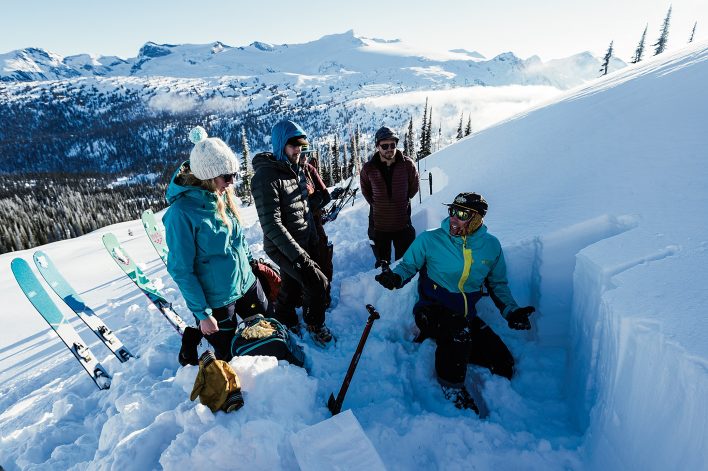It can be hard to approach backcountry skiing like a scientist, especially on bluebird powder days, but taking a note from scientists can help us sort and prioritize information. A systematic approach helps us create practiced habits that improve our decision-making process. Additionally, it can allow us to understand which data to prioritize as we gather information on changing weather, snowpack structure and more. Here’s how.

Hypothesize
Professional avalanche forecasters offer a daily hypothesis through their forecast, which I use to build my own projections about stability and conditions. Instead of starting with a blank slate, I have an opinion that will help me stick to my plan and drive decisions around what is appropriate terrain for the day’s tour.
As I spend a day out, I keep the hypothesis from the avalanche forecast and my own forecast in mind. On top of looking for the avalanche problems the forecast center told me to be aware of, I pay attention to the weather and if it is in line with what I expected. Avalanche hazard increases with rapid changes in the weather—significant snowfall, high winds, rapid warming. If any of these weather conditions exist on my tour, I will likely choose less committing terrain. My goal is to find information that doesn’t fit the forecast—to test the hypothesis through my observations.
Observe
In their book Snow Sense, pioneering avalanche forecasters and educators Jill Fredston and Doug Fessler write about the factors to look out for in the backcountry. Between warming temps, changing winds, human factors and more, one of my co-workers has counted at least 70 things to pay attention to. The problem is that we, as humans, can only pay attention to a maximum of seven things at once.
To keep myself from becoming completely overwhelmed, I break down observations and data into two categories: loud and quiet. Loud information is what I really need to pay attention to, while quiet, more subtle information comprises factors that may have a smaller influence on my decision-making or none at all.
Loud information—also sometimes called bullseye data—overrides all other data. If I observe cracking or collapsing within the snowpack or avalanche activity in the mountains, Mother Nature is screaming in my ear. It overrules any hypothesis of stable snow and forces me to adjust my terrain selection.
Another piece of loud information that I’m always on the lookout for is propagation in my snow pits—a failure and fracture traveling all the way across or up the column. If this happens during a wide column test such as the extended column test (ECT) or the propagation saw test (PST), I’ve essentially just created a mini avalanche in my pit. This tells me other avalanches are possible in the area I’m skiing. Just like other loud information, propagation tells me to take a step back and reexamine my hypothesis and plan.
Quiet information is more subtle, like Mother Nature whispering into my ear. It’s data that I have to look for but may or may not influence my decision-making in the moment. Instead, it could help me plan for tomorrow. Think information gathered from a snow pit, like snowpack layering and test results, or weather data that indicates how much loading has occurred during the last 24 to 48 hours. Mostly, quiet information helps me identify and track trends over time. By writing these observations in my field book, I can easily track these trends and use them to debrief my day and plan future tours. In the world of snow and avalanches, tracking trends helps to dictate daily terrain choices.
Execute
I have an opportunity to think like a scientist every time I go into the backcountry. By starting with a hypothesis around the avalanche hazard and where avalanche problems are located, I can refine my terrain choice for the day. Quiet pieces of information help me track trends in the snowpack. Those may influence me to change my behavior immediately or adjust it over time. But loud pieces of information have an immediate impact on my decision-making and terrain selection.
When I think about how to prioritize information—both while planning at home and when I’m in the mountains—I ask myself a series of questions. What makes the hazard increase? What makes the snow unstable? If I see things that are increasing the hazard or if I gather information that the snow is unstable—lots of new snow or wind in a short period of time, rain on dry snow, rapid warming—I adjust my terrain selection to something more conservative.
Backcountry travel can be overwhelming. There are so many moving parts—changing weather, changing snowpack, group dynamics and all the gear. In order to stay focused and sort through the noise, know the bullseye clues and pay attention to them. If you see cracking, collapsing or avalanche activity or have propagating test results in your pit, take a step back. Mother Nature is speaking up. If you are uncertain, confused or overwhelmed, take a step back and choose simpler, low-angle terrain. The one variable that is always within your control is terrain choice.
Sarah Carpenter lives in Victor, Idaho, in the straw-bale home she built with her husband. She has worn many hats in the avalanche industry—from ski patroller and guide to educator and business owner. Decision-making, especially in a winter environment, continues to intrigue her. Carpenter is equally intrigued by where to find good powder skiing; you’ll hear laughter when she’s found it.
This article was originally published in Issue #142. Snag a copy here or subscribe.










Related posts: